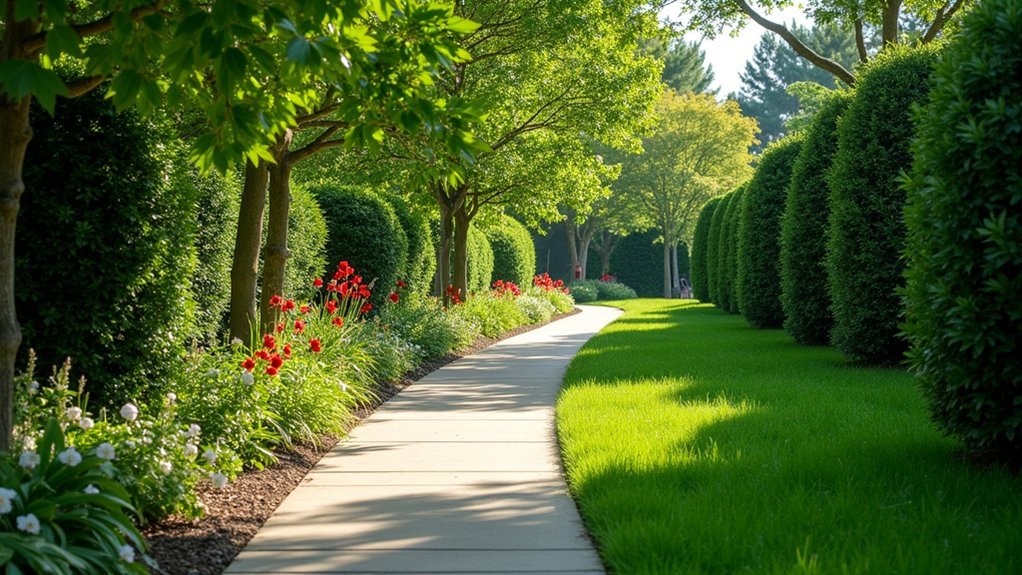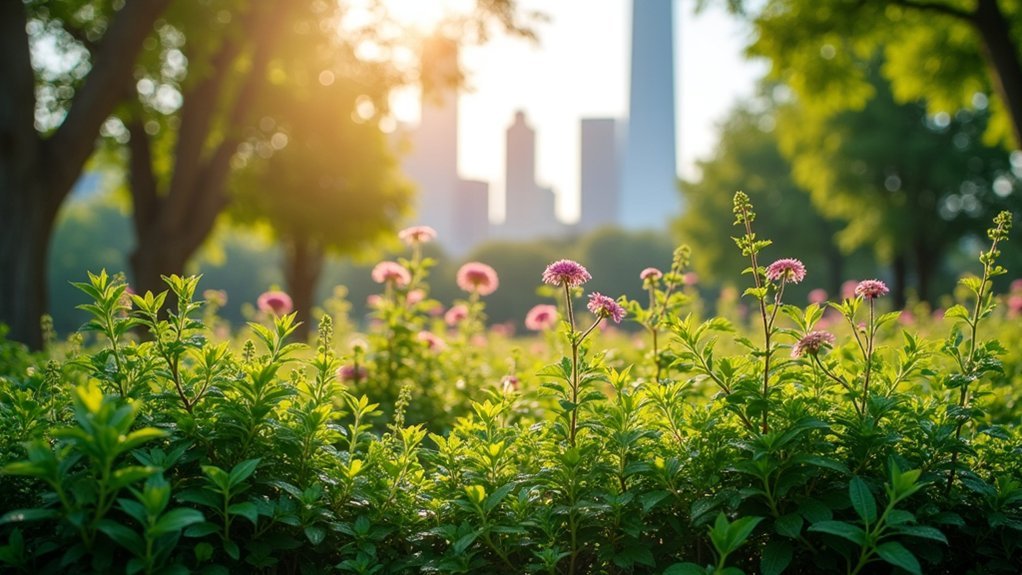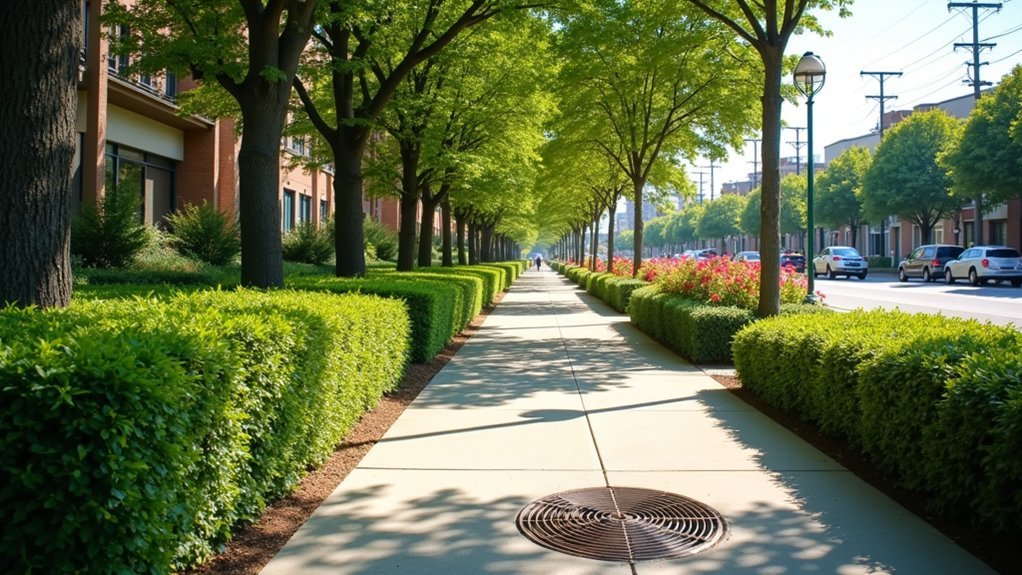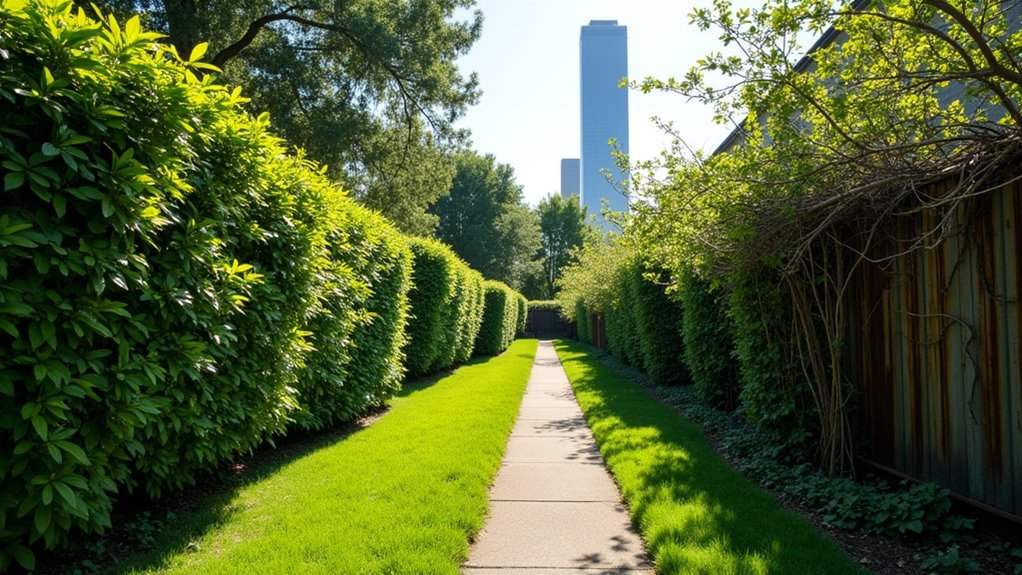Cities regulate property border vegetation to guarantee public safety by preventing hazards like hidden pedestrians and concealed signage at intersections. You’ll benefit from these rules through better traffic visibility, protected infrastructure, and increased property values—well-maintained borders can boost home prices by up to 15%. These regulations also support environmental goals by managing stormwater runoff and promoting biodiversity. Understanding these standards helps you maintain compliance while contributing to your community’s wellbeing and appearance.
6 Second-Level Headings for “Why Cities Regulate Property Border Vegetation”

While homeowners often assume they’ve complete control over their landscaping choices, cities implement vegetation regulations along property borders for several essential reasons.
These municipal zoning ordinances serve multiple public safety functions by preventing overgrowth that could obstruct visibility at intersections or impede emergency access.
Municipal zoning protects residents through vegetation management that keeps sightlines clear and allows swift emergency response.
Local governments establish vegetation guidelines to maintain neighborhood character and aesthetic continuity. Your property’s border plants aren’t just your concern—they affect community appearance and function.
Land-use restrictions also protect crucial underground infrastructure from root damage and help prevent invasive species from spreading.
As a property owner, you’ll need to comply with these regulations to avoid potential fines.
Though they might seem restrictive, these ordinances balance individual landscaping preferences with community needs, ensuring safe, functional, and visually appealing neighborhoods for everyone.
Public Safety and Visibility Concerns
Among the various reasons for regulating property border vegetation, public safety stands as a primary concern for municipalities nationwide. When you allow plants to grow unchecked along property borders, you’re potentially creating dangerous blind spots at intersections where clear sight lines are essential for traffic safety.
| Visibility Issue | Safety Impact | Municipal Response |
|---|---|---|
| Overgrown corners | Hidden pedestrians | Height restrictions |
| Concealed signage | Missed warnings | Trimming requirements |
| Blocked sightlines | Collision risk | Regular inspections |
| Obscured signals | Driving hazards | Property owner notices |
| Narrowed walkways | Pedestrian danger | Local ordinances |
Vegetation regulations guarantee that property owners maintain their landscaping responsibly. These local ordinances aren’t arbitrary—they’re carefully designed to prevent accidents by maintaining visibility at critical points. Your compliance with these standards directly contributes to neighborhood safety.
Environmental Impact and Biodiversity Management

Beyond safety concerns, the regulation of property border vegetation plays an essential role in maintaining environmental health throughout urban and suburban areas.
When you maintain diverse native plants at your property edges, you’re actively supporting local wildlife and enhancing biodiversity in your community.
Your border vegetation helps combat urban heat islands by providing shade and cooling surrounding areas.
These green spaces also manage stormwater runoff by absorbing excess water and filtering pollutants before they reach waterways.
Proper vegetation management prevents invasive species from gaining footholds that would otherwise threaten ecosystem health.
City regulations guarantee these environmental benefits while creating interconnected green spaces that improve your mental wellbeing.
Property Value Protection and Aesthetic Standards
Since your property’s appearance directly affects both your home’s value and your neighborhood’s character, cities implement border vegetation regulations to maintain consistent aesthetic standards. These local ordinances guarantee your landscaping contributes positively to the community’s visual appeal while protecting property values.
| Impact Area | Benefit of Well-Maintained Borders |
|---|---|
| Property Value | Up to 15% increase in home prices |
| Safety | Elimination of visibility hazards |
| Aesthetics | Enhanced curb appeal and design |
| Community | Improved neighborhood cohesion |
| Market | Stronger local real estate markets |
As a property owner, your compliance with vegetation standards doesn’t just prevent potential safety hazards from overgrown plants—it actively contributes to neighborhood desirability. Well-maintained borders create visual harmony that fosters community pride and protects everyone’s investment, making vegetation regulation a vital element of urban planning and property management.
Infrastructure Protection and Maintenance Access

While aesthetic appeal enhances your property’s value, proper border vegetation management also safeguards crucial community infrastructure. Municipal regulations guarantee your plants don’t interfere with public utilities and maintenance access.
When you maintain your border vegetation according to local regulations, you’re:
- Preventing root damage to sidewalks, pipes, and other critical infrastructure
- Ensuring utility workers can access public service lines during emergencies
- Supporting public safety by maintaining clear visibility at intersections
- Protecting municipal investments by reducing repair costs from vegetation damage
These regulations aren’t arbitrary—they protect essential services your community depends on.
Legal Boundaries and Encroachment Prevention
When your neighbor’s tree branches hang over your fence line, you’re facing a common property line dispute that requires understanding local vegetation ordinances.
You’ll need to consult a boundary survey to accurately determine where your property ends and your neighbor’s begins before taking action about encroaching plants.
Municipal regulations typically specify how far vegetation must be set back from property lines, so checking your city’s code can prevent costly legal confrontations while maintaining neighborly relations.
Property Line Disputes
Understanding exactly where your property ends and your neighbor’s begins represents the foundation of preventing boundary disputes.
When unclear legal boundaries exist, you’ll need professional surveys and documentation to establish precise property lines. Property line disputes often escalate when encroachment occurs—especially when your neighbor’s vegetation crosses onto your land.
If you’re facing a boundary disagreement, consider these options:
- Request mediation before pursuing costly litigation
- Research local zoning laws that regulate vegetation maintenance responsibilities
- Document any ongoing encroachment that might lead to adverse possession claims
- Consult property regulations in your municipality for height and distance requirements
Boundary Survey Requirements
Property disputes can often be prevented entirely with proper boundary documentation.
When you’re considering landscaping or construction near your property lines, boundary surveys become essential tools for vegetation management. Many local government codes require these surveys before issuing permits, ensuring your project complies with zoning regulations and respects neighboring boundaries.
Accurate boundary surveys help you avoid legal challenges that might arise from encroachment issues.
When trees, shrubs, or other vegetation cross into adjacent properties, you could face costly litigation. Professional surveyors use precise GPS technology to delineate exactly where your property ends, helping you maintain compliance with zoning ordinances.
Frequently Asked Questions
What Is One Reason Local Governments Regulate the Use of Land?
Local governments regulate land use so you’ll avoid incompatible developments near your property. They guarantee factories won’t pop up next to your home, which helps maintain your property value and neighborhood quality.
Why Do Local Governments Enforce Land Use Controls?
Local governments enforce land use controls so you’ll contribute to orderly development that prevents conflicting property uses, protects public health, preserves environmental resources, maintains community character, and helps you avoid legal disputes.
Why Do Local Governments Create Zoning Laws?
Local governments create zoning laws to help you live in well-organized communities. They’re ensuring compatible land uses, maintaining property values, promoting safety, managing infrastructure efficiently, and preserving important spaces for your community’s benefit.
What Do Local Governments Regulate Through Zoning?
Local governments regulate land use, building dimensions, setbacks, density, types of structures, parking requirements, and landscaping through zoning. You’ll need to comply with these regulations when developing or modifying your property.
In Summary
You’ll find that urban vegetation regulations aren’t arbitrary restrictions but necessary balancing acts. They’re designed to maintain public safety, protect property values, preserve infrastructure, prevent disputes, and support ecological health. When you comply with these ordinances, you’re contributing to a safer, more attractive, and better-functioning community. Understanding these reasons helps you appreciate why these rules matter for everyone’s benefit.





Leave a Reply